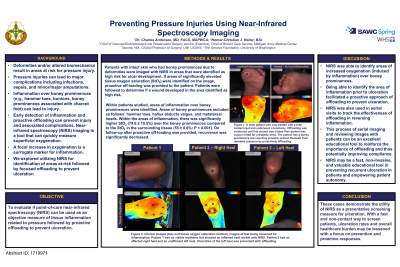Clinical Research
(CR-003) Preventing Pressure Injuries Using Near-Infrared Spectroscopy Imaging
Thursday, May 16, 2024
7:30 PM - 8:30 PM East Coast USA Time

Homer-Christian Reiter, BSc
Introduction: Deformities and/or altered biomechanics result in areas at risk for pressure injury. Pressure injuries can lead to major complications including infections, sepsis, and minor/major amputations. Inflammation over boney prominences (e.g., hammer toes, bunions, boney prominences associated with charcot foot) can lead to injury. Early detection of inflammation and proactive offloading can prevent injury and associated complications. Near-infrared spectroscopy (NIRS) imaging is a tool that can quickly measure superficial oxygenation. A focal increase in oxygenation is a surrogate marker for inflammation. Our objective was to evaluate if point-of-care near infrared spectroscopy (NIRS) can be used as an objective measure of tissue inflammation related to pressure followed by proactive off-loading to prevent ulceration.
Methods: Patients with intact skin who had boney prominences due to deformities were imaged with NIRS in areas that were identified as high risk for ulcer development. If areas of significantly elevated tissue oxygen saturation (StO2) were identified on the image, proactive off-loading was provided to the patient. Patients were followed to determine if a wound developed in the area identified as high risk.
Results: Within patients studied, areas of inflammation over boney prominences were identified. Areas of boney prominences included as follows: hammer toes, hallux abducto valgus, and metatarsal heads. Within the areas of inflammation, there was significantly higher StO2 (79.6 ± 10.5%) over the boney prominences compared to the StO2 in the surrounding tissue (55 ± 6.6%; P < 0.001). On follow-up after proactive off-loading was provided, recurrence was significantly decreased.
Discussion: These cases demonstrate the utility of using NIRS as a preventative screening measure for ulceration. With a fast and non-contact way to screen patients, ulceration rates and overall healthcare burden may be lessened with a focus on prevention.
Methods: Patients with intact skin who had boney prominences due to deformities were imaged with NIRS in areas that were identified as high risk for ulcer development. If areas of significantly elevated tissue oxygen saturation (StO2) were identified on the image, proactive off-loading was provided to the patient. Patients were followed to determine if a wound developed in the area identified as high risk.
Results: Within patients studied, areas of inflammation over boney prominences were identified. Areas of boney prominences included as follows: hammer toes, hallux abducto valgus, and metatarsal heads. Within the areas of inflammation, there was significantly higher StO2 (79.6 ± 10.5%) over the boney prominences compared to the StO2 in the surrounding tissue (55 ± 6.6%; P < 0.001). On follow-up after proactive off-loading was provided, recurrence was significantly decreased.
Discussion: These cases demonstrate the utility of using NIRS as a preventative screening measure for ulceration. With a fast and non-contact way to screen patients, ulceration rates and overall healthcare burden may be lessened with a focus on prevention.

.jpeg)